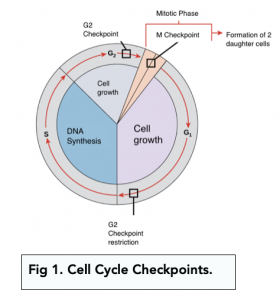Cell Division: Checkpoints and Mutations (A-level Biology)
Cell Division: Checkpoints and Mutations
Checkpoints
- There are several checkpoints performed. Transition from one phase of the cell cycle to another phase of the cell cycle is a highly regulated process. At the end of each phase, the cell undergoes a checkpoint. At the checkpoint, the cell conducts a self-assessment in order to make sure that it is not damage and to make sure that the DNA is not damaged. If the cell, or the DNA are damaged, the cell will try to repair the damage.
- Special enzymes regulate the checkpoints. These checkpoints are regulated by proteins, which monitor rate of progression through the cell cycle. Some proteins, known as tumour suppressor proteins, are responsible for checking for mutations.
- Apoptosis occurs if irreversible damage occurs. If a mutation is spotted, the tumour suppressor proteins force the cell to stop the cell cycle and attempt to repair the mutation or defect. If the cell is unable to fix the damage, the cell will enter a process known as apoptosis in which the cell will commit a highly programmed suicide. This is important in order to prevent mutations from passing onto other cells.

Development and Consequences of Mutations
Mutations occurs when the above process of self-regulation goes wrong.
- Cancer cells arise from key mutations. We have previously discussed how mutations arise in our tutorial about Synthesising Proteins from DNA. Cancer cells can arise when mutations cause the deactivation of tumour suppressor genes, which leads to the mutated cell being able to carry out cell division and grow uncontrollably. Another key mutation that must occur is the activation of oncogenes, which are genes that promote cell division and cell growth. A mutant oncogene will force the cell to rapidly divide and proliferate.
- Cancer cells can form tumours. Cancers cells grow very rapidly and are unable to control their growth. In doing so, they acquire even more mutations which cause them to grow even more uncontrollably. A group of rapidly growing cancer cells forms a rapidly growing tissue called a tumour.
- Cancers are potentially lethal. Tumours can be lethal because they take away nutrients to fuel their growth away from normal cells. Cancer cells can also invade other tissues and organs and start outcompeting the normal cells in these organs for nutrients. Ultimately, if organs are not able to obtain necessary nutrients, they will begin to stop functioning and the organism will eventually die.





Still got a question? Leave a comment
Leave a comment